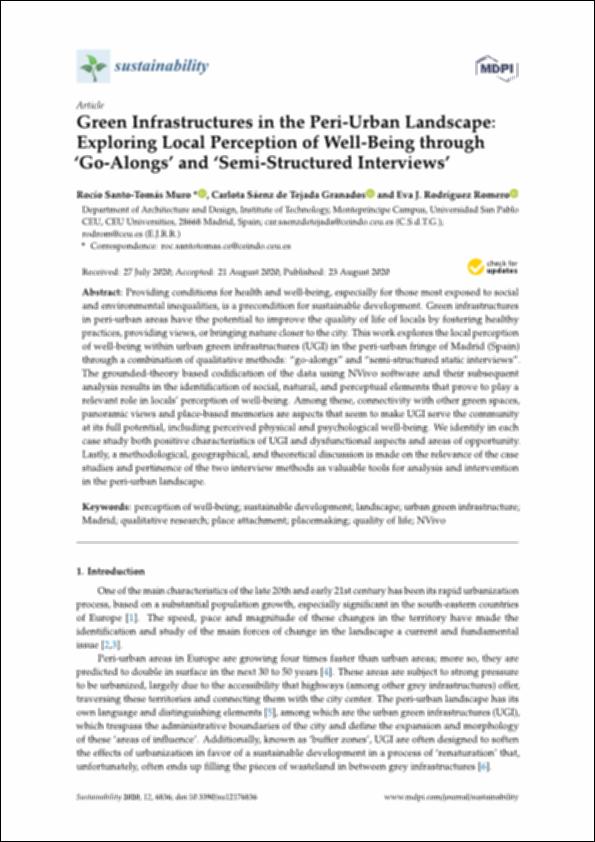Por favor, use este identificador para citar o enlazar este ítem:
http://hdl.handle.net/10637/14333Green Infrastructures in the Peri-Urban Landscape: Exploring Local Perception ofWell-Being through "Go-Alongs" and "Semi-Structured Interviews"
| Título : | Green Infrastructures in the Peri-Urban Landscape: Exploring Local Perception ofWell-Being through "Go-Alongs" and "Semi-Structured Interviews" |
| Autor : | Santo-Tomás Muro, Rocío Sáenz de Tejada Granados, Carlota Rodríguez Romero, Eva Juana. |
| Materias: | Perception of well-being; Sustainable development; Landscape; Urban green infrastructure; Madrid; Qualitative research; Place attachment; Placemaking; Quality of life; NVivo |
| Editorial : | MDPI |
| Citación : | Santo-Tomás Muro R, Sáenz de Tejada Granados C, Rodríguez Romero EJ. Green Infrastructures in the Peri-Urban Landscape: Exploring Local Perception of Well-Being through ‘Go-Alongs’ and ‘Semi-Structured Interviews’. Sustainability. 2020; 12(17):6836. https://doi.org/10.3390/su12176836 |
| Resumen : | Providing conditions for health and well-being, especially for those most exposed to social and environmental inequalities, is a precondition for sustainable development. Green infrastructures in peri-urban areas have the potential to improve the quality of life of locals by fostering healthy practices, providing views, or bringing nature closer to the city. This work explores the local perception of well-being within urban green infrastructures (UGI) in the peri-urban fringe of Madrid (Spain) through a combination of qualitative methods: “go-alongs” and “semi-structured static interviews”. The grounded-theory based codification of the data using NVivo software and their subsequent analysis results in the identification of social, natural, and perceptual elements that prove to play a relevant role in locals’ perception of well-being. Among these, connectivity with other green spaces, panoramic views and place-based memories are aspects that seem to make UGI serve the community at its full potential, including perceived physical and psychological well-being. We identify in each case study both positive characteristics of UGI and dysfunctional aspects and areas of opportunity. Lastly, a methodological, geographical, and theoretical discussion is made on the relevance of the case studies and pertinence of the two interview methods as valuable tools for analysis and intervention in the peri-urban landscape. |
| URI : | http://hdl.handle.net/10637/14333 |
| Derechos: | http://creativecommons.org/licenses/by-nc-nd/4.0/deed.es |
| Fecha de publicación : | 23-ago-2020 |
| Centro : | Universidad San Pablo-CEU |
| Aparece en las colecciones: | Escuela de Politécnica Superior |
Los ítems de DSpace están protegidos por copyright, con todos los derechos reservados, a menos que se indique lo contrario.


